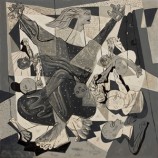A displacement of the assemblage point beyond the midline of the cocoon of man makes the entire world we know vanish from our view in one instant, as if it had been erased—for the stability, the substantiality, which seems to belong to our perceivable world, is just the force of alignment.
Certain emanations are routinely aligned because of the fixation of the assemblage point on one specific spot; that is all there is to our world. The only force that can temporarily cancel out alignment is alignment. You will have to cancel the alignment that makes you go on perceiving the world of everyday things. By intending a new position for your assemblage point and by intending to keep it fixed there long enough, you will assemble another world and escape this one.
The old seers are still challenging death until today by doing exactly that, intending their assemblage points to remain fixed in positions that place them in any of the seven worlds.
To assemble other worlds is not only a matter of practice, but a matter of intent. And it isn’t merely an exercise of bouncing out of those worlds, like being pulled by a rubber band. You see, a seer has to be daring. Once you break the barrier of perception, you don’t have to come back to the same place in the world. See what I mean?
The soundness of the world is not the mirage. The mirage is the fixation of the assemblage point on any spot. When seers shift their assemblage points, they are not confronted with an illusion, they are confronted with another world; that new world is as real as the one we are watching now, but the new fixation of their assemblage points, which produces that new world, is as much of a mirage as the old fixation.
Right now if you were to, for example, go into a state of intensified awareness, everything that you are able to do in this state is not an illusion; it is as real as the world you will face tomorrow in your daily life. However, tomorrow, the world that you are witnessing now will not exist. It only exists when your assemblage point shifts to the position where you are now.
The stalking perception
Out of all the marvelous things the old sorcerers learned exploring those thousands of positions, only the art of dreaming and the art of stalking remain. The art of dreaming is concerned with the displacement of the assemblage point. Stalking is the art that deals with the fixation of the assemblage point on any location to which it is displaced.
I intend to explain how the position of the assemblage point is like a vault where sorcerers keep their records. The energetic body knows an immensurable amount of things.
Sorcerers are capable of leaving accurate records of their findings in the position of the assemblage point. When it comes to getting to the essence of a written account, we have to use our sense of sympathetic or imaginative participation to go beyond the mere page into the experience itself. However, in the sorcerers’ world, since there are no written pages, total records, which can be relived instead of read, are left in the position of the assemblage point.
The sorcerers’ teachings on the second attention are given when the apprentice’s agglutination point is in a place that is not normal. So, the position of the agglutination point becomes the record of the lesson. To retrieve the lesson, the apprentice must return the assemblage point to the position which it occupied when the lesson was given.
It is a feat of great magnitude to bring the assemblage point back to all of the positions it has occupied during the lessons. To fixate the assemblage point on any new spot means to acquire cohesion. Dreaming does it by forcing dreamers to fixate the assemblage point.
The dreaming attention, the energy body, the second attention, the relationship with inorganic beings, the dreaming emissary are but by-products of acquiring cohesion; in other words, they are all by-products of fixating the assemblage point on a number of dreaming positions. A dreaming position is any new position to which the assemblage point has been displaced during sleep.
We fixate the assemblage point on a dreaming position by sustaining the view of any item or person in our dreams or by changing dreams at will. Through his dreaming practices, an apprentice is really exercising his capacity to be cohesive; that is to say, he is exercising his capacity to maintain a new energy shape by holding the assemblage point fixed on the position of any particular dream he is having.
Shifts of the assemblage point give rise to minute changes, which are practically unnoticeable. The challenge of shifts is that they are so small and so numerous that to maintain cohesiveness in all of them is a triumph.
That dream world exists in the precise position of his assemblage point at that moment. In order to perceive it, he needs cohesion, that is, he needs to maintain his assemblage point fixed on that position.
Others would perceive that same world if they had uniformity and cohesion. Uniformity and cohesion is to hold, in unison, the same position of the assemblage point. The old sorcerers called the entire act of acquiring uniformity and cohesion outside the normal world.
The art of stalking, as I have already said, deals with the fixation of the assemblage point. The old sorcerers discovered, through practice, that important as it is to displace the assemblage point, it is even more important to make it stay fixed on its new position, wherever that new position might be.
Related Articles













